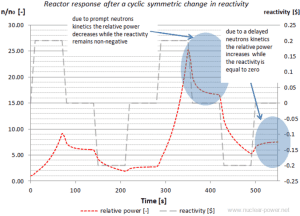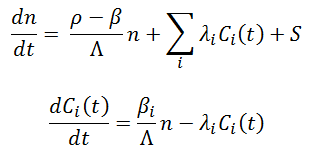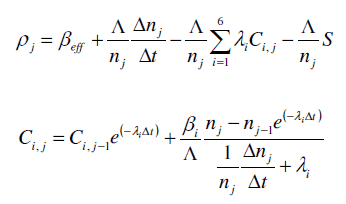The reactivity describes the measure of a reactor’s relative departure from criticality. It is important to monitor the system’s reactivity during reactor operation and reactor startup. It must be noted reactivity is not directly measurable, and therefore most power reactors procedures do not refer to it, and most technical specifications do not limit it. Instead, they specify a limiting rate of neutron power rise (measured by excore detectors), commonly called a startup rate (especially in the case of PWRs).
 On the other hand, during reload startup physics tests performed at the startup after refueling the commercial PWRs, it is important to monitor subcriticality continuously during the criticality approach. On-line reactivity measurements are based on the inverse kinetics method, and the inverse kinetics method is a reactivity measurement based on the point reactor kinetics equations. This method can be used for:
On the other hand, during reload startup physics tests performed at the startup after refueling the commercial PWRs, it is important to monitor subcriticality continuously during the criticality approach. On-line reactivity measurements are based on the inverse kinetics method, and the inverse kinetics method is a reactivity measurement based on the point reactor kinetics equations. This method can be used for:
- Reactivity measurement at high neutron level – reactimeter without source term. A reactimeter can be constructed without source term, but it works only at higher neutron levels, where the neutron source term in point reactor kinetics equations may be neglected.
- Reactivity measurement at subcritical multiplication – reactimeter with source term. For operation at low power levels or in the sub-critical domain (e.g., during criticality approach), the contribution of the neutron source must be taken into account, and this implies the knowledge of a quantity proportional to the source strength and then it should be determined. The subcritical reactimeter is based on the determination of the source term (source strength).
As was written, the system’s reactivity can be measured by a reactimeter. The reactimeter is a device (or rather a computational algorithm) that can continuously give real-time reactivity using the inverse kinetics method. The reactimeter usually processes the signal from source range excore neutron detectors and calculates the system’s reactivity.
It was shown that the source term is not easy to determine, and the problem is that it is of the highest importance in the subcritical domain. One recognized method for source term determining is known as Least Squares Inverse Kinetics Method (LSIKM).
Special reference: Seiji TAMURA, “Signal Fluctuation and Neutron Source in Inverse Kinetics Method for Reactivity Measurement in the Sub-critical Domain,” J. Nucl. Sci. Technol, Vol.40, No. 3, p. 153–157 (March 2003)
Inverse Kinetics – Equations
The exact point kinetics equations that can be derived from the general neutron balance equations without making any approximations are:
where:
- n(t) is the neutron density in the core (which is proportional to the detector count rate)
- Ci(t) is the precursor’s density of delayed neutrons of group i
- Λ is the prompt generation time
- ρ is the reactivity
- the constants βi and λi are the fraction and decay constant of delayed neutron precursor of group i
- S(t) is the source term, which characterizes the number of neutrons (source neutrons) added to the system from an external source. As can be seen, the source term does not influence the system’s dynamics since it does not influence the system’s reactivity.
According to Seiji TAMURA, the Inverse Kinetics equations (flux ⟶ reactivity) for discrete-time series data can be derived from the ordinary point kinetics equations (reactivity ⟶ flux), assuming that the reactor power change for the interval of Δt is as n(t)=nj-1exp(μjt), where μj = log(nj/nj-1)/Δt:
When the reactor power is at a steady-state no, seven initial conditions can be obtained as:
The equation for ρj provides a real-time reactivity calculation for successive reactor power data. When the reactor is operating at a sufficiently high power level, the last term of the right side, the source term, may be neglected because it becomes negligible.
For operation at low power levels or in the sub-critical domain (e.g., during criticality approach), the contribution of the neutron source must be taken into account, and this implies the knowledge of a quantity proportional to the source strength and then it should be determined. Otherwise, zero reactivity will be obtained for any subcritical reactor condition (after the transition phenomena have died out). The source term can be determined using data from a transient state after introducing a given reactivity. The source term can be determined from data from the rod drop experiment using the Least Squares Inverse Kinetics Method (LSIKM).
Special reference: M. Itagaki, A. Kitano, “Revised source strength estimation for inverse neutron kinetics,” Preprints 1999 Fall Mtg., At. Energy Soc. Jpn., Hiroshima, Japan, G20, (1999)
Special reference: Renato Yoichi Ribeiro Kuramoto, Anselmo Ferreira Miranda. SUBCRITICAL REACTIVITY MEASUREMENTS AT ANGRA 1 NUCLEAR POWER PLANT. 2011 International Nuclear Atlantic Conference – INAC 2011. ISBN: 978-85-99141-04-5.


